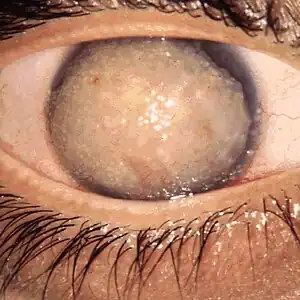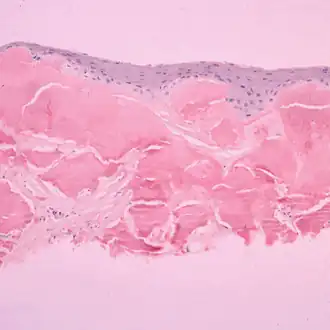Gelatinous drop-like corneal dystrophy
| Gelatinous drop-like corneal dystrophy | |
|---|---|
| Other names: Subepithelial amyloidosis of the cornea | |
 | |
| A completely opaque cornea with multiple drop-like nodular opacities. Some blood vessels are present in the opaque cornea | |
Gelatinous drop-like corneal dystrophy, also known as Primary familial amyloidosis of the cornea or amyloid corneal dystrophy, is a rare form of corneal dystrophy. The disease was described by Nakaizumi as early as 1914.[1]
Signs and symptoms
The main pathological features in this dystrophy are mulberry-shaped gelatinous masses beneath the corneal epithelium. Patients suffer from photophobia, foreign body sensation in the cornea. The loss of vision is severe. The amyloid nodules have been found to contain lactoferrin, but the gene encoding lactoferrin is unaffected.
This form of corneal amyloidosis appears to be more frequent in Japan.[2]
Genetics
A number of mutations causing this disease have been described in the M1S1 (TACSTD2) gene encoding Tumor-associated calcium signal transducer 2, but not all patients have these mutations, suggesting involvement of other genes.[3]
Diagnosis
The evaluation of Gelatinous drop-like corneal dystrophy can be done via light microscopy[4]
 Light microscopy view of subepithelial deposit of amyloid
Light microscopy view of subepithelial deposit of amyloid Apple green dichroism of subepithelial deposition of amyloid viewed under polarized light. Congo red stain.
Apple green dichroism of subepithelial deposition of amyloid viewed under polarized light. Congo red stain.
Treatment
Recurrence within a few years occurs in all patients following corneal transplantation. Soft contact lenses are effective in decreasing recurrences.
References
- ↑ Nakaizumi, K. : A rare case of corneal dystrophy. Acta. Soc. Ophthal. Jpn. 18: 949-950, 1914
- ↑ Online Mendelian Inheritance in Man (OMIM): 204870
- ↑ Klintworth GK (2009). "Corneal dystrophies". Orphanet J Rare Dis. 4 (1): 7. doi:10.1186/1750-1172-4-7. PMC 2695576. PMID 19236704.
- ↑ RESERVED, INSERM US14-- ALL RIGHTS. "Orphanet: Gelatinous drop like corneal dystrophy". www.orpha.net. Archived from the original on 5 December 2021. Retrieved 24 November 2022.
External links
| Classification | |
|---|---|
| External resources |
|
Template:Human corneal dystrophy